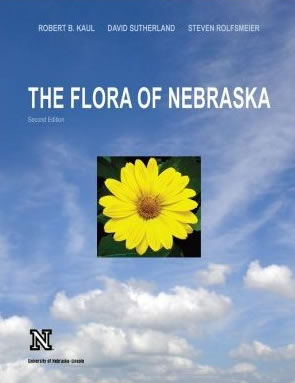
The second edition of Flora of Nebraska, newly available, is not for the faint of heart, but will be the standard reference for serious botanists. At 967 pages, it covers nearly 2000 species and incorporates thousands of updates based on new plant sightings and on changes in taxonomy.
The book’s co-authors, Nebraska botanists who have collaborated for decades, span three campuses: Robert Kaul, research professor and curator of botany at the University of Nebraska State Museum, Lincoln; David Sutherland, University of Nebraska at Omaha biology professor emeritus; and Steven Rolfsmeier, herbarium director at Chadron State College.
The first edition, released in 2007, was the first comprehensive inventory of knowledge on plants found in the wild in Nebraska since 1936, including maps of which species have been found in which counties. Extension agents, ranchers and others around the state then provided more information on where to find different species. “It’s been a real stimulus,” Kaul said. “It’s been an invitation for people to do work, and we’ve said that throughout the book. We’ve found a few plants that hadn’t been seen in a century or more. They’ve been there all along but nobody has seen them.”
Rediscovered plants include wintergreen, not seen from 1911 until 2005, and water mare’s tail, not sighted between 1893 and 2009.
In addition to updates from users, the second edition reflects the latest developments in taxonomy. Some species were “lost” because their classification merged with another species, while others were added when one species split into two.
Several collections of color photos illustrate invasive species that have been introduced to the state, such as the common reed; endangered species, such as certain types of milkweed, lilies and an orchid; plants you’d expect to find, such as native trees, flowers, cacti and fungi; and distinctive landscapes, including the Sand Hills, tall- and short-grass prairies, the Pine Ridge and a salt marsh.
Flora of Nebraska is being used as a textbook on advanced plant taxonomy, in weed management, by natural resource managers, and by serious hobbyists willing to work with scientific terminology, Kaul said.
Published by the Conservation and Survey Division, School of Natural Resources, University of Nebraska, the volume is available for $80 at the Nebraska Maps and More Store, in the first-floor lobby of Hardin Hall at 33rd and Holdrege streets on UNL’s East Campus. The store is open from 8 a.m. to 5 p.m. Monday through Friday, and can be found online at http://nebraskamaps.unl.edu/. The book is also available on Amazon and at local and regional booksellers.
-- Kelly Helm Smith, School of Natural Resources